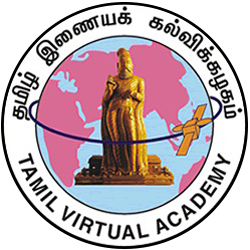Primary tabs
-
LESSON - 1 History of literature - Eleventh CenturyA0 4131 பதினோராம் நூற்றாண்டு
In this lesson you will learn about the importance given to religion by the kings of Tamilnadu in the eleventh century. Good literary works like கல்லாடம் and grammatical works like யாப்பருங்கலம், யாப்பருங்கலக் காரிகை and வீரசோழியம் appeared during this period.
The first unit brings out the rise of grammar and literary works in the eleventh century. கல்லாடம் is a literary work, which formed the basis for later religious works and also the contacts with the sanskrit literature. Nature is treated so nicely that people would be tempted to read this again and again. Similarly excellent grammatical works leading to later treatises also appeared.
The second unit deals with the appearance of a large number of commentaries on the early literatures. சிலப்பதிகாரம் and திருக்குறள் were explained by authors of significance. Even grammatical works in poetic form needed such commentators to popularise them.
The third unit focuses on saivite literature. ஒன்பதாம் திருமுறை is an important contribution during this period. It is an anthology comprising திருவிசைப்பா and திருப்பல்லாண்டு. The compiler of this anthology was நம்பியாண்டார் நம்பி. His writings are found in பதினோராம் திருமுறை.
The fourth unit concentrates on Vaishnavite literature of this century. Mostly individual poems praising the Vaishnavite saints and poets appeared. திருக்கச்சி நம்பி, and திருமலை நம்பி belong to this group of poets, who thus glorified the Vaishnavite saints. Such solitary poems are called தனியன்கள்.
Many other creations during this time include பிரபந்த இலக்கியம் like பரணி, உலா, கோவை and தூது. They are also called சிற்றிலக்கியம்.
Thus the literary production in this century was not as good as in the previous years. Comentaries came out in large number during this period. They exceeded the original writings. Another variety of literary contribution called collection or compilation was also noticed during this period.
From this lesson you can understand that the growth of literature and grammar was in slow pace and original works were less in number. Religion formed the content of many works of this era.






